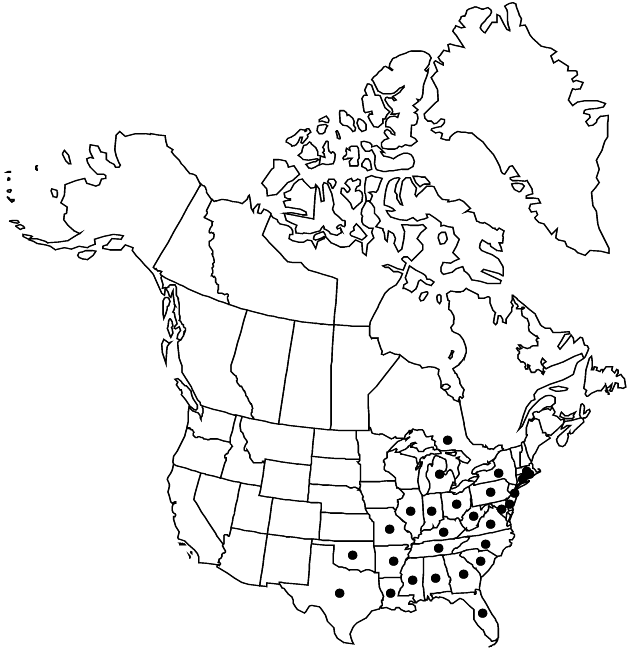familyAsteraceae
genusSolidago
sectionSolidago sect. Solidago
subsectionSolidago subsect. Venosae
speciesSolidago rugosa
subspeciesSolidago rugosa subsp. aspera
varietySolidago rugosa var. aspera
Solidago rugosa var. aspera
Rhodora 17: 7. 1915.
Endemic
Basionym: Solidago aspera Aiton Hort. Kew. 3: 212. 1789
Herbage moderately to densely hairy. Distal cauline leaf-blades lanceolate to elliptic, not much reduced distally. Heads in wide arrays, usually with elongate proximal branches greatly exceeding subtending leaves. Rays florets 5–10.2n = 18, 36.
Phenology: Flowering Aug–Nov.
Habitat: Sandy, silty, and clay soils, fields, thickets, edges of woods, roadsides, ditches
Elevation: 0–1200+ m
Distribution

Ont., Ala., Ark., Conn., Del., Fla., Ga., Ill., Ind., Ky., La., Md., Mass., Mich., Miss., Mo., N.J., N.Y., N.C., Ohio, Okla., Pa., R.I., S.C., Tenn., Tex., Va., W.Va.
Discussion
Variety aspera is the common race of the species in the southeastern United States. It also occurs infrequently further north to Michigan and Massachusetts. It is most commonly tetraploid, with diploids also occurring through the range.
Selected References
None.
Lower Taxa
None.
"longest" is not a number."thick" is not a number.
... more about "Solidago rugosa var. aspera"
glabrate +
introrse +
connate +
sessile +
serrate +
stiff +
distinct +
herbaceous +
68mm;104mm +
flowering +
prominent +
hairy +
acute +
scarious +
hirsute +
papillate +
cone--shaped +
wide +
continuous +
not 3-nerved +
withering +
not persisting +
decurrent +
sessile +
serrate +
flowering +
prominent +
hispido-strigose +
ovate;elliptic;lanceolate;acute;attenuate +
ribbed +
leafy-bracteate +
divergent +
recurved +
proximalmost +
elongate +
stigmatic +
barbellate +
longer +
persistent +
25;45 +
absent +
woody +
sessile +
absent +
ampliate +
monomorphic +
dimorphic +
strigillose +
0.9mm;1.5mm +
staminate +
reduced +
straight +
sessile +
serrate +
resinous +
flowering +
distal +
prominent +
hispido-strigose +
acute;attenuate +
20mm;25mm +
distinct +
proximal +
1;5 +
bisexual +
dispersed +
secund +
discoid +
singly +
compact to lax +
indeterminate +
50;1500 +
hairy +
clavate +
surrounding +
campanulate +
1mm;1.6mm +
0.4mm;0.7mm +
3-nerved +
pronounced +
rugose-nerved +
alternate +
proximal +
distal +
usually blunt-toothed;subentire +
firm +
erect;spreading +
? (?) +
sessile +
serrate +
flowering +
prominent +
hispido-strigose +
scarious +
attenuate +
3-nerved +
translucent +
pronounced +
reduced +
sessile +
serrate +
flowering +
prominent +
hispido-strigose +
setiform +
2-carpellate +
inferior +
attached +
anatropous +
persistent +
hispido-strigillose +
tough +
thick +
absent +
connate +
not persisting +
eglandular +
resinous +
not striate +
persistent +
distinct +
falling +
stipitate-glandular +
unequal +
3-nerved +
ovate-oblanceolate +
arching +
elongate +
withering +
flowering +
largest +
flowering +
Rhodora +
1915 +
pistillate +
absent +
fertile +
epaleate +
pitted +
convex +
long-creeping +
woody +
fibrous +
exalbuminous +
modifed +
3;4 +
Endemic +
alternate +
branched +
erect +
triangular +
2-branched +
glabrous +
Solidago rugosa var. aspera +
Solidago rugosa subsp. aspera +
variety +
shorter +
not persisting +
perennial +